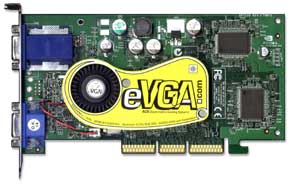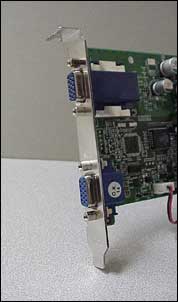|
Enjoy the Views
Our customers asked...and we listened. Due to popular demand for a multi-monitor solution for the GeForce4 MX 440, EVGA.com is pleased to announce the release of the e-GeForce4 MX 440 Dual Display video card. Equipped with dual DB15 VGA connectors, users can now connect up to two analog display devices and enjoy the benefits of multi-monitor applications. Based on the cost-effective, yet high-performance GeForce4 MX 440 graphics processor, this card is designed to allow everyone to experience a world of advanced 3D graphics that the GeForce4 MX line can provide, including performance attributes that advances over the older GeForce2 MX technology such as Lightspeed Memory Architecture™ (LMA) II, Accuview Antialiasing™, as well as nView™ multi-display support. Imagine the usefulness and flexibility of two monitors on one desktop PC.
This is now possible with the e-GeForce4 MX 440 Dual Display video card! Lightspeed Memory Architecture II - An obstacle affecting the realism of many artificially rendered scenes was the memory bottleneck present on modern cards. NVIDIA Lightspeed Memory Architecture™ (LMA) II picks up where the GeForce3 left off, further improving how memory data is retrieved from cache. The Quad Cache features four individually dedicated memory caches, each optimized for instant memory access. Other memory enhancements include 4:1 lossless Z-compression technology and a second generation Z-occlusion culling, a technique that predetermines pixel rendering for objects hidden behind other objects thereby saving valuable memory bandwidth. Accuview Antialiasing - An ongoing trend to achieve this in depth look and feel is a move towards antialiasing, the technological process of removing the “jaggies” that can affect realism of a 3D image. This can be accomplished through NVIDIA’s patent pending Accuview Antialiasing™ technology with modes of 2X, 4X, Quincunx and new 4XS mode. The concern of utilizing antialiasing in games or graphic applications was the performance hit to the system. Now full screen antialiasing can operate at speeds where antialiasing was turned off. nView Technology - The final piece to the puzzle is the nView technology that feeds the growing demand for a multi-display solution. More and more users are adopting this trend for either a home and work environment where a user can watch their favorite DVD movie on their television set while writing an email to a friend on the other. An example of a work application includes the stock broker, monitoring his stocks on one computer screen while reading the morning reports on the other. The effect is to enlarge the existing Windows desktop to span across two display devices running the gamut of analog CRT monitors, digital flat panel or LCD screens as well as television sets through an S-Video port. The availability of these features depends on the connector configuration on your card. Availability -The e-GeForce4 MX 440 Dual Display will be available late May 2002.
|
||||||||||||||||||||
 Introducing
the e-GeForce4 MX 440
Introducing
the e-GeForce4 MX 440
